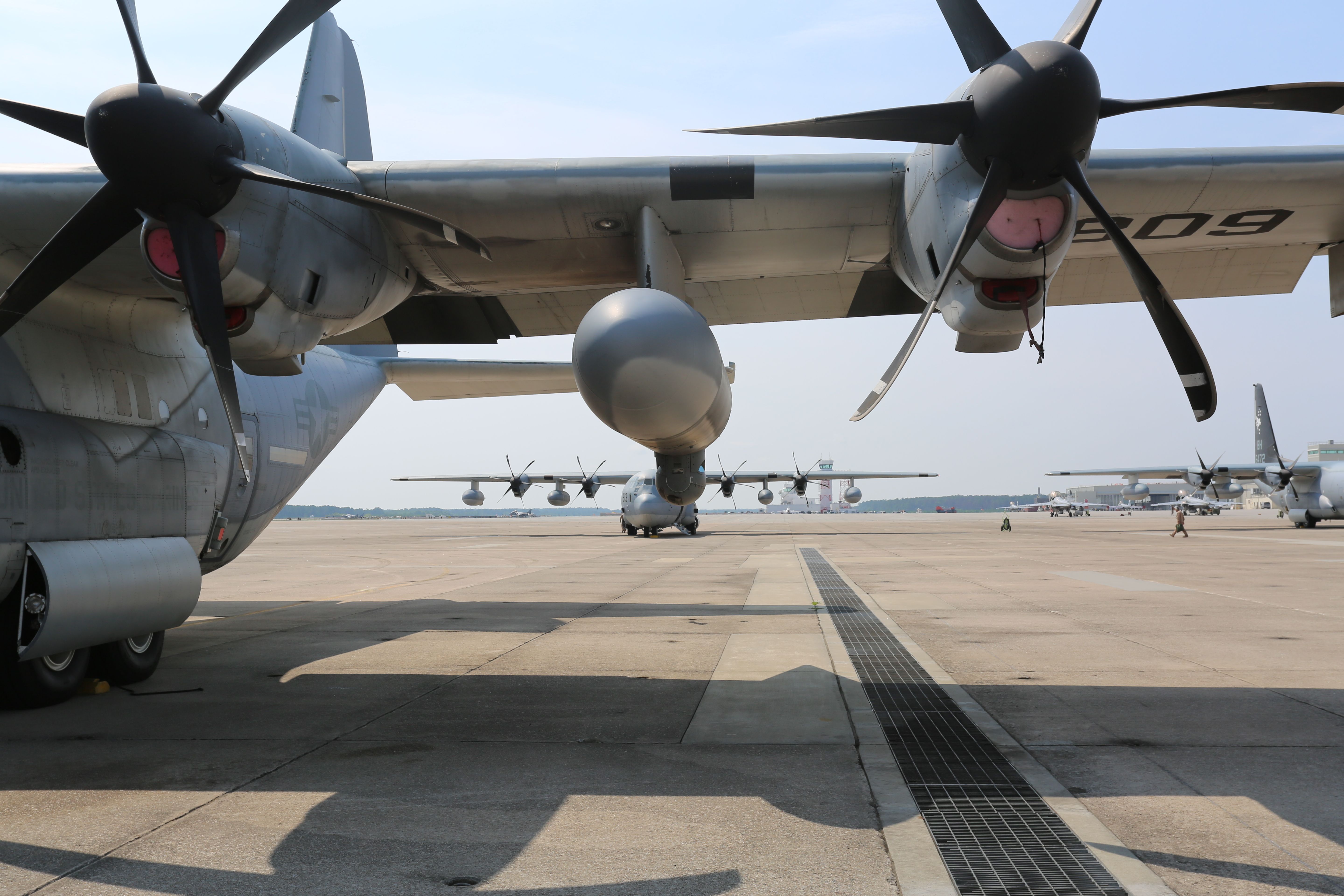2014-06-29 By Robbin Laird
Recently, I have had the chance to visit the USS America, interview with Ed Timperlake the head of the Military Sealift Command and to spend several days with Second Marine Air Wing, including watching the change of command for VMX-22.
We will have several pieces coming out over the next few weeks which will capture in detail the thoughts and approaches being taken by the players shaping the future of core aspects of the USN-USMC team in facing the twenty-first century.
But having done this unusual confluence of visits, several observations certainly suggest themselves more generally about the evolution of 21st century capabilities being generated by the Navy and the USMC.
Clearly, new technologies are being introduced to shape new capabilities and approaches.
And there will be a creative tension between the new and the old, with the ongoing challenge of reshaping concepts of operations to stay ahead of the game.
We will always have the reactive enemy, and the cycle of innovation is not just a game, it is as Mike Wynne often has said the challenge of avoiding the fair fight.
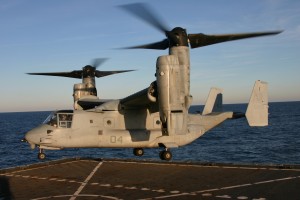
It is clear at the same time that the technologies being introduced will not always be understood and their integration into the force takes time, and several years of hard work undergone before the nascent capabilities become realized.
Nowhere is this clearer than with regard to the Osprey.
In the forthcoming interview with the Commanding General of the 2nd MAW, Major General Robert F. Hedelund, the CG reflected on his own career and noted that he was slated to become a VMM or Osprey commander but it did not happen and he became an HMM or helicopter commander instead.
Innovation takes time.
The interview with MG Hedelund highlights a look back and a look forward with regard to the 2nd MAW.
In my own experience of having come to 2nd MAW each year for a number of years, the key role of the command in USMC innovation is clear.
When I did my first interviews with regard to the Osprey, not only was 2nd MAW the only place one could find them, there were not many to find.
2nd MAW is where the Ospreys deployed first to Iraq and then to Afghanistan.
2nd MAW is the birthplace of the Special Purpose MAGTFs.
And Harvest Hawks, the latest iteration of KC-130J innovation, can be found here as as well.
2nd MAW is no stranger to innovation.
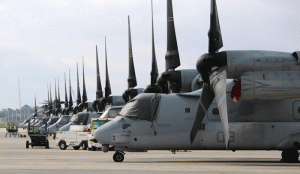
When Murielle Delaporte and I visited this past February, she noted that the tarmac was filled with Ospreys and given her experience with European Air Forces was clearly impressed with the sheer size and scope of what had become of the maturation of the “Osprey nation.”
The Osprey has become completely integrated into the USMC so much so that one can speak of the USMC as the only tiltrotar enabled assault force in the world.
This means that the “devil dogs” can insert at a reach and range that no other ground force in the world can aspire to.
Recently, a senior Marine was asked: “What will the next generation of tiltrotar aircraft look like?”
An interesting question, but the core point is that the cultural change, which has accompanied the Osprey, has simply reshaped the USMC.
If one does not go through the cultural changes and reshape the concepts of operations, the technology will not be effective or maximized.
This point was highlighted by the new Deputy Commandant of Aviation who himself was the CG of 2nd MAW when honoring the outgoing CO of VMX-22.
“Dog” Davis underscored that taking good ideas and putting them into reality required a key proclivity towards innovation.
The innovation which VMX-22 fostered in close cooperation with other elements of the Marine Corps was really about taking the Osprey and wring out its full operational value and truly making the Marines a tiltrotar assault force.
The USS America
Visiting the USS America highlights how significant the Osprey has become to the future of an amphibious assault force.

This is the first ship ever built with the Osprey in mind. It can now be fully maintained below deck as opposed to sharing time on the flight deck to do maintenance duties.
The visit along with the interviews with Captain Hall and Major “Fez” Schreiner (forthcoming) highlighted the impact of such a ship as a lead element in shaping an amphibious task force.
According to Captain Hall:
The flight deck is about the size of a legacy LHA. But that is where the comparison ends. By removing the well deck, we have a hangar deck with significant capacity to both repair aircraft and to move them to the flight deck to enhance ops tempo.
With the Ospreys, we will be able to get the Marines into an objective area rapidly and at significant distances. And when the F-35B comes the support to the amphibious strike force is significantly enhanced.
And we will be able to operate at much greater range from the objective area.
With the concern about littoral defenses, this ship allows us the option to operate off shore to affect events in the littoral.
This is a major advantage for a 21st century USN-USMC team in meeting the challenges of 21st century littoral operations.
VMX-22 Coming to the USS America
And in an interview with the new CO of VMX-22, Col. Robert L. Rauenhorst, highlighted his first major task as flying to the USS America in route around South America and working the integration of the Osprey with the ship.
It will not hurt that the Colonel has recently served in SOUTHCOM and knows the geographical area well as well.
Colonel Rauenhorst reported to U.S. Marine Corps Forces, South in July 2011 and assumed the duties as MARFORSOUTH, AC/S G-3.
As Operations Officer, he coordinated, planned, and oversaw the execution of U.S. Marine forces in the SOUTHCOM AOR supporting the national security strategy to Counter Transnational Organized Crime, including a SPMAGTF embarked onboard USS OAK HILL, over 80 theater security cooperation events, and additionally he served as OIC for a detachment of 200 Marines and Sailors in support of Operation MARTILLO from Guatemala
Shaping an Amphibious Task Force: The MSC Contribution
The visit to Military Sealift Command underscored the importance of understanding the changing nature of the amphibious task force, and the supply chain to support its operations.
The head of the Military Sealift Command, Rear Admiral Thomas Shannon, in a forthcoming interview, highlighted the importance of re-shaping the MSC working relationship with the USN-USMC team to deliver more effective capabilities for what might be called an amphibious task force.
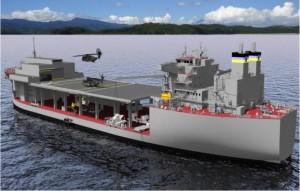
Our interview will be published soon, but in a piece published earlier this month, the Admiral was quoted along these lines:
“We are not out to replace, for example, amphibious warfare,” Shannon said.
“We have a fantastic amphibious warfare capability within our Navy.
But these new classes of ship under construction … are going to be involved in operations that lean towards the littoral environment where amphibious warfare takes place.”
A good illustration of the innovation generated from the MSC to the USN-USMC team is the USNS Montford Point.
Earlier this month, testing of the capabilities of the ship to work to deliver significant infantry vehicles to the shore was conducted. The USNS Montford Point will be part of the task force enabling the fleet to deliver the necessary ground support mobile elements.
And the new variant of the USNS Montford Point will deliver new capabilities as well. MLP-3 and its successors will have a flight deck to support broader support operations as well.
The difference between the two designs of the USNS Montford Point has been described as follows:
The main difference in these two ship’s design will be a large elevated flight deck that will be capable of supporting relatively large forces of heavy and light helicopters.
There will also be hangar facilities and expanded jet fuel storage capacity to ensure continuous flight operations even in very remote areas of the world.
Visiting 2nd MAW: June 2014
This month’s visit to 2nd Marine Air Wing also provided significant insights into other forms of innovation, which are being pursued by the USMC.
The first aspect during my visit was a chance to talk to many of the members of Marine Aerial Refueler Transport Squadron 252.
The problem is that the name of the squadron does not really capture what it has become within the context of changing USMC concepts of operations.
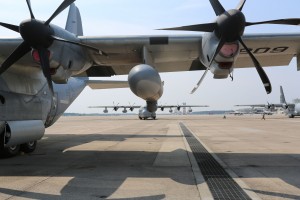
A better way to understand the evolution is to highlight the broadened concept of support, which the KC-130Js and their crews provide the MAGTF and deployed Marines.
The Harvest Hawk has introduced significant change in how the crew aboard a KC-130J operations, and it itself, is simply a transitional experience, as the F-35 and the UAVs are introduced into the force and send data to the KC-13OJ as a potential node in the battlespace.
And finally, time was spent with the CO and his team for working the UAV equation.
Lt. Col. Kristopher Faught, VMU-2 Commanding Officer, highlighted the contextual role of UAVs in the evolving concept of how the Marines thought of Information War and Electronic Warfare and saw the F-35s and UAVs working closely together in the future digital fight.
Obviously, tight resources will constrain the ability to shape the full up capabilities from innovative efforts.
The demand side on MSC ships, KC-130Js and other support assets is very high and going up as the Marines execute the distributed laydown in the Pacific.
The nation will have to address these shortfalls in order to ensure complete mission success.
And military leaders will need to focus upon and invest in where we are going, not where we have been.
And recognizing that assets such as the Osprey and the F-35 are not a replacement for anything; they are a pathway to the future.


